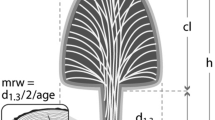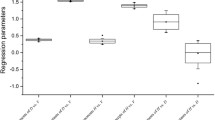Abstract
Growth curves of stem volume without bark were analyzed on the basis of theu-w diagram and the growth model equivalent to the Bertalanffy model. Some trees experienced several growth phases, in which characteristic values of growth changed. Presumable factors to cause the shifting of growth phase were discussed. In a 130-year-old sugi at Kaneyama in Yamagata Prefecture, estimated rates of anabolism and catabolism were related by a linear relationship with time delay of about 30 years.
Similar content being viewed by others
References
Bertalanffy, L. von 1949. Problems of organic growth. Nature163: 156–158.
Causton, D.R. andJ.C. Venus. 1981. The Biometry of Plant Growth. Edward Arnold, London.
Hagihara, A. andK. Hozumi 1986. An estimate of the photosynthetic production of individual trees in aChamaecyparis obtusa plantation. Tree Physiol1: 9–20.
Hozumi, K. 1985. Phase diagrammatic approach to the analysis of growth curve using theu-w diagram—Basic aspects—. Bot. Mag. Tokyo98: 239–250.
Hunt, R. 1982. Plant Growth Curves. The Functional Approach to Plant Growth Analysis. Edward Arnold, London.
Kohyama, T. 1982. Studies on theAbies population of Mt. Shimagare II. Reproductive and life history traits. Bot. Mag. Tokyo95: 167–181.
Mine, I. 1951. Big sugi stand at Kaneyama. Akita Regional Forestry Office (Akita) (in Japanese with English summary).
Miyaura, T. andK. Hozumi. 1985. Measurement of litterfall in a hinoki (Chamaecyparis obtusa S. and Z.) plantation by the clothing-trap method. J. Jap. For. Soc.67: 271–277.
Myers, C.A. 1963. Vertical distribution of annual increment in thinned ponderosa pine. For. Sci.9: 394–404.
Nakashizuka, T. 1983. Regeneration process of climax beech (Fagus crenata Blume) forests III. Structure and development process of sapling populations in different aged gaps. Jap. J. Ecol.33: 409–418.
—. 1984. Regeneration process of climax beech (Fagus crenata Blume) forests. IV. Gap formation. Jap. J. Ecol.34: 75–85.
— andM. Numata. 1982a. Regeneration process of climax beech forests. I. Structure of a beech forest with the undergrowth ofSasa. Jap. J. Ecol.32: 57–67.
——. 1982b Regeneration process of climax beech forests. II. Structure of a beech forest under in fluences of grazing. Jap. J. Ecol.32: 473–482.
Ninomiya, I. andK. Hozumi. 1981. Respiration of forest trees (I) Measurement of respiration inPinus densithunbergii Uyeki by an enclosed standing tree method. J. Jap. For. Soc.63: 8–18.
——. 1983. Respiration of forest trees (II) Measurement of nighttime respiration in aChamaecyparis obtusa plantation. J. Jap. For. Soc.65: 193–200.
Oberhettinger, F. 1970. Hypergeometric functions.In: M. Abramowitz and I.A. Stegun, ed., Handbook of Mathematical Functions with Formulas, Graphs, and Mathematical Tables p. 555–565. Dover Publ., New York.
Shibata, H. 1984. Growth analysis of forest trees. Graduation thesis at Nagoya University (in Japanese).
Shidei, T. (ed.) 1963. Productivity of forest ecosystems in terms of cycling of matter. Material1: 231–232 (in Japanese).
—. 1965. Productivity of forest ecosystems in terms of cycling of matter. Material2: 258, 300–320 (in Japanese).
Shinozaki, K. andT. Kira. 1958. On the growth curve. Modern Biol.6: 1–24. Kyoritsu Publ., Tokyo (in Japanese).
Suzuki, E. 1979. Regeneration ofTsuga sieboldii forest. I. Dynamics of development of a mature stand revealed by stem analysis data. Jap. J. Ecol.29: 375–386 (in Japanese with English summary).
— 1980. Regeneration ofTsuya sieboldii forest. II. Two cases of regenerations occurred at 260 and 50 years ago. Jap. J. Ecol.30: 333–346 (in Japanese with English summary).
— 1981a. Regeneration ofTsuga sieboldii forest. III. Regeneration under a canopy gap with low density level of conifer seedlings and a method for estimating the time of gap formation. Jap. J. Ecol.31: 307–316 (in Japanese with English summary).
—. 1981b. Regeneration ofTsuga sieboldii forest. IV. Temperate conifer forests of Kubotani-yama and its adjacent area. Jap. J. Ecol.31: 421–434.
Watanabe, S. 1985. Dendrosociological Studies ofNatural Forest in Hokkaido, Japan. Hokkaido Regional Forestry Office, Sapporo (in Japanese).
Author information
Authors and Affiliations
Rights and permissions
About this article
Cite this article
Hozumi, K. Analysis of growth curve of stem volume in some woody species using theu-w diagram. Bot. Mag. Tokyo 100, 87–97 (1987). https://doi.org/10.1007/BF02488422
Received:
Accepted:
Issue Date:
DOI: https://doi.org/10.1007/BF02488422




